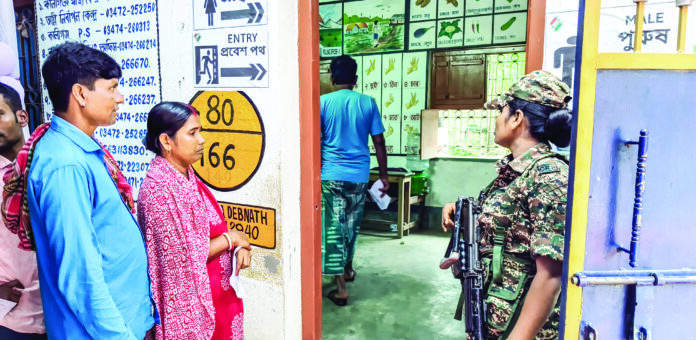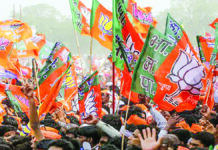
KOLKATA: As expected in a Muslim-majority area, last week, the Trinamool Congress comfortably won the byelection to the Kaliganj Assembly constituency in West Bengal’s Nadia district, with a margin of more than 50,000 votes over its BJP rival. However, a deep dive into the numbers throws up an interesting indication—rising Hindu consolidation—that could reshape West Bengal’s political future in the Assembly elections due next year.
The byelection was necessitated by the death of the sitting Trinamool Congress legislator, Nasiruddin Ahmed, in February this year. Trinamool chief Mamata Banerjee nominated his daughter, Alifa Ahmed, who defeated her BJP rival Ashish Ghosh. Alifa Ahmed polled 102,759 votes, which represented a vote share of 55.15%. BJP’s Ashish Ghosh got 52,710 votes (28.29% vote share), while the Congress candidate (backed by the Left) got 28,348 votes (15.21% vote share).
The Trinamool Congress held up this victory, and the fact that the BJP’s vote share had decreased from 30.91% in 2021 to 28.29% in the bypoll while its own share had increased, as proof of Mamata Banerjee’s continuing popularity.
The Trinamool touted the 1.8% increase in its vote share and the decline of 2.62% in the BJP’s vote share to claim that while Mamata Banerjee’s popularity had not only remained intact but also increased, while the BJP’s “communal politics” had been rejected by the people of Bengal.
The Congress-Left combine also drew solace from the fact that its vote share increased by 3.23% (from 11.98% in 2021 to 15.21% this time).
However, a close analysis of the results of the byelection reveals that a substantial consolidation of Hindu votes has happened in Kaliganj.
Of the 309 polling booths in the Kaliganj Assembly constituency, Hindus form a majority of the electorate in 109 polling booths. Hindus form a very small percentage of the electorate in the remaining 200 polling booths.
In 108 of the 109 polling booths where Hindus are in a majority, the BJP got a large section of the votes. In only one booth (Booth No. 12) which has 592 voters, of whom 351 voted, the BJP polled only 132 votes of the 351 votes that were cast. It is only in this booth that a majority of the Hindus voted in favour of the Trinamool Congress.
“Overall, we got nearly 73% of the votes in the 108 polling booths where Hindus form a majority. This is very encouraging for us. Hindus are becoming politically aware and voting intelligently,” Leader of Opposition and senior BJP leader Suvendu Adhikari told The Sunday Guardian.
“The ruling party almost always wins a byelection. And in a Muslim-majority seat, there is no way we could have won. But despite that, we did well,” said Adhikari.
As for the decline in the BJP’s vote share, Adhikari ascribed it to rigging and false voting by Trinamool cadres and his own party’s inability to ensure that party supporters could go to vote fearlessly.
“We didn’t have enough workers on the ground to prevent rigging and to bring out voters. The Trinamool threatened and terrorised our voters, so many of them could not vote,” he said.
“Many of our voters had also told us they would not vote because this was a byelection and there was no point voting in a byelection because the outcome would not have any effect on the power equation in the state. They have assured us they will vote in next year’s Assembly elections,” explained Adhikari.
Also, Adhikari added, of the 2.34 lakh voters in Kaliganj, Hindus number about 1.1 lakh. About 66% (about 72,600) of these Hindu voters exercised their franchise. BJP received 52,710 votes, which means the BJP got 72.6% of the Hindu votes.
BJP state president Sukanta Majumdar ascribed the increase in the vote share of the Left-supported Congress candidate to “machinations by the Trinamool”.
“The Trinamool realises that the BJP is the biggest threat and will unseat them from power. So, they propped up the Congress candidate and helped him in order to cut BJP votes. The Trinamool asked a small section of its supporters to vote for the Congress candidate in order to create the impression that the Congress-Left is staging a political comeback in Bengal at the expense of the BJP. But such games will not yield any results in the 2026 Assembly elections,” said Sukanta Majumdar.
“Kaliganj has sent out a good signal. If Hindu votes consolidate in 220 of the 294 Assembly seats in Bengal, Mamata Banerjee will surely be ousted from power,” Adhikari said.
Muslims form above 30% of the electorate in 102 Assembly constituencies, and the BJP has won some of these seats in 2021. In 74 of these seats, Muslims are in a majority and a Hindu (BJP) candidate cannot hope to win any of those 74 seats.
“But if this trend of consolidation of Hindu votes continues, and we will try our best to ensure that it does, then we will surely win the 2026 Assembly elections,” said Adhikari.
In the 2024 Lok Sabha elections, about 69% of the Hindus who exercised their franchise voted for the BJP. But the turnout of Hindu voters was quite low at 65%, while that of Muslims ranged between 90% and 94%.
The challenge before the BJP, admitted Adhikari, is to motivate a much larger number of Hindus to vote and also to get an additional 5% of Hindu votes.
“If we can get about 80% of the Hindus to vote, and if we can increase our share of Hindu votes to about 74%, we will win the 2026 elections,” said Adhikari.
Political commentator Suman Chattopadhyay said: “The ghastly attacks on Hindus in the Murshidabad riots, including the brutal killing of a father-son duo, displacement of hundreds of Hindu families and destruction of properties of Hindus as well as desecration or destruction of Hindu temples have scared Hindus all over the state. And that’s why the Hindus of Kaliganj voted in large numbers for the BJP. If this becomes a trend in West Bengal during the Assembly elections, then Mamata will be in trouble.”







